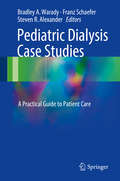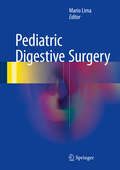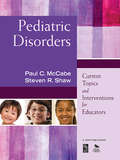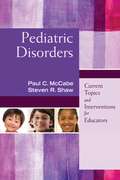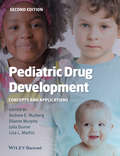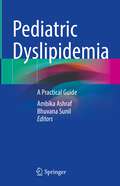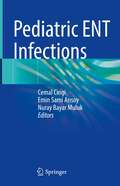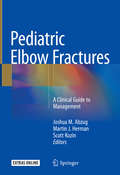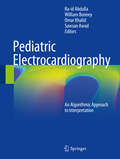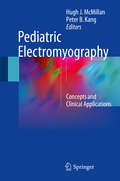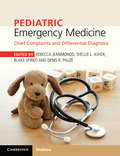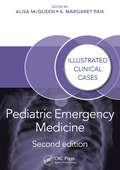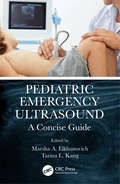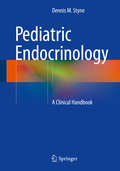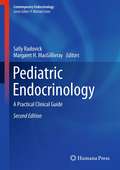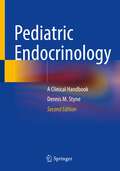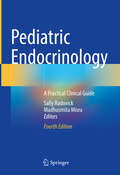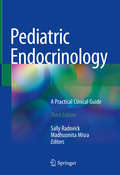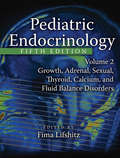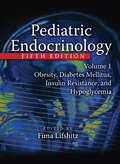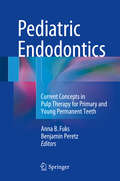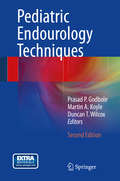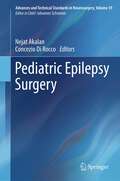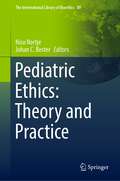- Table View
- List View
Pediatric Dialysis Case Studies
by Steven R. Alexander Franz Schaefer Bradley A. WaradyEdited by the same team that developed the successful Pediatric Dialysis and its second edition, this text features clinical management principles that are integral to the care of children receiving chronic dialysis. Each chapter is introduced by a case presentation that serves as the basis for key learning points that are clinically applicable and presented in a succinct manner. The topics included in Pediatric Dialysis Case Studies cover virtually all aspects of pediatric dialysis care and represent the efforts of an international group of experts with firsthand clinical expertise from all disciplines represented in the pediatric dialysis team. This resource is certain to help the clinician achieve improved outcomes for these often complex patients.
Pediatric Digestive Surgery
by Mario LimaThis book presents and explains the latest developments in surgery for congenital digestive tract malformations, tumors, abdominal trauma, and the most important acquired digestive disorders. Particular attention is paid to minimally invasive and innovative techniques. In addition to clear descriptions of the surgical procedures that highlight useful tips and tricks, for each condition the clinical presentation is well illustrated and information is provided on pathogenesis. The book also includes general chapters that address the anatomy of the abdomen in children, diagnostic issues, the problem of clinical nutrition, and other aspects of management in pediatric patients with gastrointestinal pathologies. Pediatric Digestive Surgery will serve as a comprehensive and up-to-date reference for all pediatric surgeons. It will provide the trainee with easily understood, concise guidance while offering the more experienced surgeon valuable updates on the latest thinking and practice in the field.
Pediatric Disorders: Current Topics and Interventions for Educators
by Steven R. Shaw Dr Paul C. McCabeThe educator’s go-to reference for important pediatric health topics! Based on up-to-date research, this volume outlines the most current and urgent pediatric issues affecting schools today. Written for school psychologists, counselors, administrators, and teachers, this easy-to-understand resource covers: <p><p> Schools as partners in health care delivery, including health care delivery trends and collaborations between educators and medical professionals <p> Current issues in pediatric disorders and treatments, such as childhood immunizations, shaken baby syndrome, sleep problems, and pediatric HIV <p> Prevention and wellness intervention for childhood obesity, low-level aggression in the schools, and accident prevention
Pediatric Disorders: Current Topics and Interventions for Educators
by Paul C. Mccabe Steven R. ShawMedical issues in schools are a growing reality. In addition to teaching academic skills, educators now play an integral part in comprehensive health care delivery for children. Based on current research, this volume outlines the most current and urgent pediatric issues affecting schools today. Written for school psychologists, counselors, administrators, and teachers, this easy-to-understand resource covers: -Schools as partners in health care delivery, including health care delivery trends and collaborations between educators and medical professionals -Current issues in pediatric disorders and treatments, such as childhood immunizations, shaken baby syndrome, sleep problems, and pediatric HIV -Prevention and wellness intervention for childhood obesity prevention, low-level aggression in the schools, and accident prevention Featuring case studies, classroom strategies, discussion questions, glossaries, and handouts, Pediatric Disorders provides valuable information to practitioners involved in providing differentiated instruction and educational accommodations, collaborating with families, working with the community, and influencing policy.
Pediatric Drug Development
by Lisa L. Mathis Julia Dunne Dianne Murphy Andrew E. MulbergPediatric Drug Development, Second Edition, encompasses the new regulatory initiatives across EU, US and ROW designed to encourage improved access to safe and effective medicines for children. It includes new developments in biomarkers and surrogate endpoints, developmental pharmacology and other novel aspects of pediatric drug development.
Pediatric Dyslipidemia: A Practical Guide
by Ambika Ashraf Bhuvana SunilPediatric lipidology is a relatively new field of pediatrics. Premature cardiovascular diseases account for 30% of mortality in the United States. There is a heightened awareness regarding early recognition, prevention and management of childhood dyslipidemia. This book fulfils the need for a concise, quick-reference guide on clinical approach to the management of pediatric lipid disorders. Rational and optimal medical practice approaches are outlined throughout the text. Current clinical guidelines for treatment of genetic and acquired pediatric dyslipidemias are reviewed with an emphasis on new data and novel therapeutic options. This book is aimed to guide clinical decisions and improve care of at-risk youth in the primary prevention of premature atherosclerotic cardiovascular disease. Written by experts in the field, Pediatric Dyslipidemia includes the most up-to-date scientific and clinical information for pediatricians, endocrinologists, primary care practitioners and any other medical practitioners treating children with dyslipidemia.
Pediatric ENT Infections
by Cemal Cingi Nuray Bayar Muluk Emin Sami ArısoyThe book provides a comprehensive and up-to-date overview of pediatric ENT infections. It brings together the experience of authors from more than 30 countries and aims to provide a broader understanding of the prevention and treatment of infectious diseases in children, that will likely lead to improve their health globally. In addition to new infections like COVID-19, the work reviews the latest treatments modalities. The list of topics ranges from basic to very advanced and the book will be therefore an invaluable resource for ENT and pediatrics trainees and students, as well as for experienced practitioners in these fields.
Pediatric Elbow Fractures: A Clinical Guide To Management
by Martin J. Herman Joshua M. Abzug Scott KozinThis unique text focuses entirely on the treatment of pediatric elbow fractures, which encompass the vast majority of operative cases for pediatric fracture care, and which can be challenging to even the most experienced surgeon. The book opens with a survey of the basic anatomy and development of the elbow, as well as examination and imaging techniques. Both acute and chronic fractures are then discussed in detail, beginning with a brief outline of the epidemiology, classification, and work-up of each fracture, but the main focus will be on providing a master’s approach to the surgical treatment of these injuries, including supracondylar fractures, capitellar shear fractures, elbow dislocations, Monteggia fracture dislocations, and cubitus varus and valgus, among others. Numerous photographs, figures and videos will enable the orthopedic surgeon, hand surgeon, and trauma surgeon to be fully prepared to treat any of these fractures.
Pediatric Electrocardiography
by Ra-Id Abdulla William Bonney Omar Khalid Sawsan AwadThis book elucidates the process of reading electrocardiograms (ECGs) in children. It provides a structured, step-by-step guide for interpreting ECGS using algorithms, which allow clinicians to decipher the data within these tracings and establish differential diagnoses. The book also presents actual high-definition ECG tracings, which are annotated and highlighted to demonstrate the issues discussed. Topics include cellular electrophysiology changes and electrocardiography and disorders such as axis abnormalities, heart rate and rhythm disturbances, hypertrophy, conduction abnormalities, and fetal arrhythmias. Clinical scenarios with answers provide real-life examples of how pediatric patients present, their ECGs, and treatment methodology. Pediatric Electrocardiography: An Algorithmic Approach is a valuable resource for pediatricians, family medicine physicians, cardiologists, and medical students.
Pediatric Electromyography
by Hugh J. Mcmillan Peter B. KangThis book describes how to perform nerve conduction studies and electromyography in children, and explains the relevant physiology and anatomy crucial to making a diagnosis. Relevant case presentations are included to aid learning, and the authors also focus on the practical applications of the test results, including discussions of major neuromuscular diseases amenable to diagnosis via electromyography. Pediatric Electromyography: Concepts and Clinical Applications is aimed at residents, technologists and staff pediatric neurologists, as a practical guide and exam study guide.
Pediatric Emergency Medicine: Chief Complaints and Differential Diagnosis
by Rebecca Jeanmonod Shellie Asher Blake Spirko Denis R. PauzéPediatric patients are a unique subset of emergency patients, making up about one-quarter of all emergency department visits. Textbooks regarding the care of pediatric patients are almost universally organized by organ system, which does not facilitate an efficient diagnosis. Taking a case-based approach, Pediatric Emergency Medicine: Chief Complaints and Differential Diagnosis is arranged by chief complaint, using real patient scenarios to help the reader work through the inductive and deductive reasoning needed to assess, evaluate, treat, and disposition pediatric patients with urgent complaints. Cases are structured in the way in which they are presented during medical care, allowing practitioners to become comfortable with the general structure of case presentations: chief complaint, HPI, PMH, ROS, exam, and ancillary studies. This volume also discusses disease processes and their differentiations, providing in-depth knowledge regarding current standards of diagnosis and care.
Pediatric Emergency Medicine: Illustrated Clinical Cases, Second Edition (Illustrated Clinical Cases)
by Alisa McQueen S. PaikThis book includes 200 clinical cases which present as emergencies. Congenital and acquired conditions affecting all body systems in infants and children are covered, including allergy, abuse, burns, fractures and other trauma, feeding problems, foreign bodies, genetic disorders, infections, poisoning, haematology, oncology, and much more. Cases appear in random order, reflecting actual practice in emergency medicine, and reinforcing skills in investigation, diagnosis, and treatment. It is superbly illustrated with high-quality radiographic images and photographs and is indispensable for all health professionals dealing with emergencies involving children.
Pediatric Emergency Ultrasound: A Concise Guide
by Marsha A. Elkhunovich Tarina L. Kang Courtney Brennan Kathryn Pade Rashida Campwala Jessica Rankin Kristin BeronaThis concise, portable manual provides practitioners and future practitioners with a basic guide to pediatric emergency ultrasound, enabling them to learn the fundamentals of bedside ultrasound and use these to refresh their skills prior to, or when, performing it on a patient.
Pediatric Emergency and Critical Care Ultrasound
by Stephanie J. Doniger MD RDMS FAAP FACEPEmergency bedside ultrasound assessment is well established for adult patients, but has only recently been introduced into everyday clinical practice for the care of pediatric patients. Pediatric Emergency Critical Care and Ultrasound is a concise, practical text which explains the principles of ultrasound, its diagnostic application in all organ systems and its use as a procedural adjunct. Both well-established and innovative applications are described, assisting the practitioner in incorporating ultrasound into daily practice, facilitating patient care and decreasing radiation exposure. Case studies and abundant illustrations enable the reader to study the appropriate techniques in detail and learn from real examples from the pediatric emergency department and intensive care unit. Pediatric Emergency Critical Care and Ultrasound is the first comprehensive bedside ultrasonography resource focusing on pediatric patients and is essential reading not only for pediatric emergency medicine subspecialists but for all emergency physicians, intensivists/critical care physicians and pediatricians.
Pediatric Endocrinology
by Dennis M. StyneThis text provides a concise, straightforward and clearly written approach for the evaluation of common topics in pediatric endocrinology. Pediatricians, family physicians, residents, fellows and medical students will benefit from the discussion of endocrine physiology and its application to common clinical practice. The text presents the major signs and symptoms and the diagnosis and management of pediatric endocrine disorders. The information presented can prepare a provider for communication with parents of a child with an endocrine condition and may allow the practitioner to avoid an unnecessary consultation. The concepts covered in the text are designed to address the first 10 headings in the content outline of the Sub-board of Pediatric Endocrinology of The American Board of Pediatrics with varying degrees of specificity. The Suggested Reading sections at the conclusion of each chapter direct the reader to outstanding larger and more detailed texts, manuscripts and websites which offer increased detail.
Pediatric Endocrinology
by Sally Radovick Margaret H. MacgillivrayA state-of-the-art and concise guide to the clinical management of pediatric endocrine disorders, the second edition of the highly regarded Pediatric Endocrinology: A Practical Clinical Guide covers the most common and challenging conditions seen by practicing endocrinologists and primary care physicians, including growth, hypothalamic, pituitary, adrenal, thyroid, calcium and bone, and reproductive disorders, as well as metabolic syndromes. This expanded second edition includes new topics being seen more commonly in pediatric endocrinology practices related to obesity and type 2 diabetes mellitus and lipid disorders. Each chapter contains an introductory discussion of the problem, a review of the clinical features that characterize it, the criteria needed to establish a diagnosis, and a comprehensive therapy section delineating the risks and benefits of the best therapeutic options available. Invaluable tables summarize the critical factors in etiology, clinical presentation, diagnosis, and therapeutic dosages. Pediatric Endocrinology: A Practical Clinical Guide, Second Edition, is a comprehensive resource for all clinicians concerned with the myriad endocrinologic disorders seen in children and adolescents.
Pediatric Endocrinology: A Clinical Handbook
by Dennis M. StyneNow in a revised and expanded second edition, this concise, straightforward and clearly written text presents the latest information on the evaluation and management of common issues and conditions in pediatric endocrinology. Endocrinologists, pediatricians, family physicians, residents, fellows and medical students will all benefit from the discussion of endocrine physiology and its application to common clinical practice. As in the original edition, the text presents the major signs and symptoms in the diagnosis and management of pediatric endocrine disorders, often allowing the practitioner to avoid an unnecessary consultation and preparing a provider for informed communication with parents of a child with an endocrine condition. The concepts covered in the text are designed to address the first 10 headings in the content outline of the Sub-board of Pediatric Endocrinology of The American Board of Pediatrics: disorders of the hypothalamic-pituitary axis, growth, calcium metabolism and bone, the thyroid gland, puberty, and the adrenal gland, among others. Concluding each chapter is a Suggested Reading section, directing the reader to outstanding larger and more detailed texts, manuscripts and websites that offer increased detail.Practical and user-friendly, Pediatric Endocrinology, Second Edition is not simply a checklist of everything that could be done but leads the reader toward a more specific goal of what should be done.
Pediatric Endocrinology: A Practical Clinical Guide
by Sally Radovick Madhusmita MisraNow in its revised and updated fourth edition, this state-of-the-art clinical textbook presents the current diagnosis and management of pediatric endocrine diseases and disorders as seen by practicing endocrinologists and primary care physicians. Seven thematic sections present the latest evidence for the management of growth, hypothalamic, pituitary, adrenal, thyroid, calcium and bone, and reproductive disorders, as well as metabolic syndromes and endocrine emergencies. This fourth edition includes new topics such as conditions of overgrowth, low bone density and its management, endocrine issues related to sexual identity, mineralocorticoid disorders and endocrine hypertension, and endocrine emergencies. All chapters have been expanded to discuss recent advances in the field, and each chapter contains key points, an introductory discussion of the problem, a review of the clinical features that characterize it, the criteria needed to establish a diagnosis, and a comprehensive therapy section delineating the risks and benefits of the best therapeutic options available. Completing each chapter are concluding sections presenting relevant case material and multiple-choice review questions for students, residents and fellows. Pediatric Endocrinology: A Practical Clinical Guide, Fourth Edition is a comprehensive resource for all clinicians concerned with the myriad endocrine disorders seen in children and adolescents.
Pediatric Endocrinology: A Practical Clinical Guide (Contemporary Endocrinology)
by Sally Radovick Madhusmita MisraA state-of-the-art and concise resource presenting the clinical management of pediatric endocrine diseases and disorders, this third edition of the highly regarded textbook covers the most common and challenging conditions seen by practicing endocrinologists and primary care physicians, including growth, hypothalamic, pituitary, adrenal, thyroid, calcium and bone, and reproductive disorders, as well as metabolic syndromes. This expanded third edition includes new topics such as conditions of overgrowth, low bone density and its management, endocrine issues related to sexual identity, mineralocorticoid disorders and endocrine hypertension, and endocrine emergencies. Some existing chapters are expanded to take into account recent advances in the field. Each chapter contains key points, an introductory discussion of the problem, a review of the clinical features that characterize it, the criteria needed to establish a diagnosis, and a comprehensive therapy section delineating the risks and benefits of the best therapeutic options available. New to this edition are concluding sections in each chapter containing relevant case material and multiple choice review questions. Pediatric Endocrinology: A Practical Clinical Guide, Third Edition is a comprehensive resource for all clinicians concerned with the myriad endocrinologic disorders seen in children and adolescents.
Pediatric Endocrinology: Growth, Adrenal, Sexual, Thyroid, Calcium, and Fluid Balance Disorders
by Fima LifshitzCelebrating more than twenty years as the single best source in the field, this Fifth Edition has now expanded into two cornerstone volumes with 53 fully inclusive chapters and 73 renowned contributors that comprehensively address every topic and trend relevant to the identification, diagnosis, and management of endocrine and endocrine-related diso
Pediatric Endocrinology: Obesity, Diabetes Mellitus, Insulin Resistance, and Hypoglycemia
by Fima LifshitzCelebrating more than twenty years as the single best source in the field, this Fifth Edition has now expanded into two cornerstone volumes with 53 fully inclusive chapters and 73 renowned contributors that comprehensively address every topic and trend relevant to the identification, diagnosis, and management of endocrine and endocrine-related diso
Pediatric Endodontics
by Anna B. Fuks Benjamin PeretzThis book provides dental professionals with a clear understanding of current clinical and scientific knowledge on the various aspects of pulp treatment for both primary and young permanent teeth. Diagnostic parameters are clearly presented, along with step-by-step descriptions of clinical procedures, including indirect and direct pulp treatments, pulpotomy, and pulpectomy. The rationale for the materials used in each technique and their individual merits and disadvantages are examined in detail. In the case of pulpotomy, all the materials used since the introduction of this treatment modality are discussed (e. g. , formocresol, glutaraldehyde, ferric sulfate, and MTA) and the roles of sodium hypochlorite, electrofulguration, and laser therapy are elucidated. Special attention is devoted to pulpectomy and root canal treatment, with consideration of debriding and obturation techniques, rinsing solutions, and root-filling pastes. A further individual chapter is dedicated to restorations of teeth treated with the different types of pulp therapy. The various conservative treatment modalities are also presented, including specific treatments for immature nonvital permanent teeth. The concluding chapter looks to the future and the potential value of stem cells in pulp therapy.
Pediatric Endourology Techniques
by Duncan T. Wilcox Prasad P. Godbole Martin A. KoylePediatric Urology has rapidly developed as a separate subspecialty in the last decade. During this time, significant advances in technology and instrumentation has meant that increasingly more procedures can be performed by the minimally invasive route. However, access to and availability of adequate training facilities and resources continues to hinder surgeons in achieving experience and expertise in the minimally invasive techniques in paediatric urology. Pediatric Endourology Techniques 2nd edition is a fully illustrated text with an accompanying web application which addresses these issues. The aim of this 2nd edition is to enable surgeons to carry out commonly performed minimally invasive pediatric urological procedures. This book has been organised systematically to enable quick reference to the topic of interest. It encompasses not only the majority of commonly performed pediatric endourological procedures in a standardised format but also newer techniques and procedures that have developed since publication of the first edition. A list of specific relevant reading material is given at the end of each chapter. Pediatric Endourology Techniques 2nd Edition is a valuable tool for pediatric urologists as well as pediatric surgeons, general surgeons, adult urologists and those with an interest in minimally invasive surgery.
Pediatric Epilepsy Surgery
by Concezio Di Rocco Nejat AkalanThe contributions in this volume cover recent advances and changing concepts on diagnosis and treatment of resistant epilepsy in children. Topics treated are new insights on mechanisms of epileptogenesis in developing brain, multimodality imaging in pediatric intractable epilepsy, pediatric intractable epilepsy syndromes, pediatric temporal lobe epilepsy surgery, critical review of palliative surgical techniques for intractable epilepsy, treatment modalities for intractable epilepsy in hypothalamic hemartomas, contemporary management of epilepsy in tuberous sclerosis.
Pediatric Ethics: Theory and Practice (The International Library of Bioethics #89)
by Nico Nortjé Johan C. BesterThis book assists health care providers to understand the specific interplay of the roles and relationships currently forming the debates in pediatric clinical ethics. It builds on the fact that, unlike adult medical ethics, pediatric ethics begins within an acutely and powerfully experienced dynamic of patient-family-state-physician relationship. The book provides a unique perspective as it interacts with established approaches as well as recent developments in pediatric ethics theory, and then explores these developments further through cases. The book first focuses on setting the stage by introducing a theoretical framework and elaborating how pediatric ethics differ from non-pediatric ethics. It approaches different theoretical frameworks in a critical manner drawing on their strengths and weaknesses. It helps the reader in developing an ability to engage in ethical reasoning and moral deliberation in order to focus on the wellbeing of the child as the main participant in the ethical deliberation, as well as to be able to identify the child’s moral claims. The second section of the book focuses on the practical application of these theoretical frameworks and discusses specific areas pertaining to decision-making. These are: the critically ill child, new and enduring ethical controversies, and social justice at large, the latter of which includes looking at the child’s place in society, access to healthcare, social determinants of health, and vaccinations. With the dynamic changes and challenges pediatric care faces across the globe, as well as the changing face of new technologies, no professional working in the field of pediatrics can afford not to take due note of this resource.
